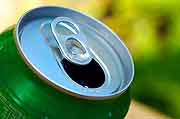
MONDAY, Dec. 13 (HealthDay News) — Taxing sodas and other sweetened drinks would result in only minimal weight loss, although the revenues generated could be used to promote obesity control programs, new research suggests.
Adding to a spate of recent studies examining the impact of soda taxes on obesity, researchers from Duke-National University of Singapore (NUS) Graduate Medical School looked at the impact of 20 percent and 40 percent taxes on sales of carbonated and non-carbonated beverages, which also included sports and fruit drinks, among different income groups.
Because these taxes would simply cause many consumers to switch to other calorie-laden drinks, however, even a 40 percent tax would cut only 12.5 daily calories out of the average diet and result in a 1.3 pound weight loss per person per year, researchers said.
A 20 percent tax would equate to a daily 6.9 calorie intake reduction, adding up to no more than 0.7 pounds lost per person per year, according to the statistical model developed by the researchers.
“The taxes proposed as a remedy are largely on the grounds of preventing obesity, and we wanted to see if this would hold true,” said study author Eric Finkelstein, an associate professor of health services at Duke-NUS. “It’s certainly a salient issue. I assumed the effects would be modest in weight loss, and they were.”
“I believe that any single measure aimed at reducing weight is going [to be small],” Finkelstein added. “But combined with other measures, it’s going to add up. If higher taxes get people to lose weight, then good.”
As part of a growing movement to treat unhealthy foods as vices such as tobacco and liquor, several states in recent years have pushed to extend sales taxes to the purchase of soda and other sweetened beverages, which, like other groceries, are usually exempt from state sales taxes.
Other motions have seemed to target the poor, such as New York City Mayor Michael Bloomberg’s proposal earlier this year to ban sugared drinks from groceries that could be purchased by residents on food stamps.
Finkelstein’s study, reported online Dec. 13 in the Archives of Internal Medicine, showed that high soda taxes wouldn’t impact weight among consumers in the highest and lowest income groups. Using in-home scanners that tracked households’ store-bought food and beverage purchases over the course of a year, the data included information on the cost and number of items purchased by brand and UPC code among different population groups.
Researchers estimated that a 20 percent soda tax would generate about $1.5 billion in annual revenue in the United States, while a 40 percent tax would generate about $2.5 billion. The average household cost would be $28.
Finkelstein explained that wealthier households seemed impervious to the tax because they can afford to pay it, while poorer income groups weren’t as affected because they tend to buy lower-priced generic products or buy in bulk.
“It’s largely very cheap calories for them,” he said, adding that store brands such as Wal-Mart cola also contain more calories than the name-brand Coke.
Dr. Stephen Cook, an assistant professor of pediatrics at Golisano Children’s Hospital at the University of Rochester Medical Center (URMC), said the study is valuable because it echoes the results of others similar to it.
“It’s good to see an amount of replication in the findings,” said Cook, also an assistant professor of URMC’s Center for Community Health. “It brings up an important point of how we should address obesity, as a disease or a public health threat.”
Despite the modest weight loss resulting from the soda taxes, both Finkelstein and Cook support such a measure as one of many possible ways to attack obesity, which affects one-third of Americans.
As for the revenue generated, it can also tackle obesity if it’s funneled toward weight-control programs and not other government initiatives, Cook said.
“The other side of the taxing coin is what we do with the money,” Cook said. “We need to take the revenue and use it for interventional programs instead of it being used as a money grab. I think it’s good when it’s properly done and the money is used for those strategies.”
Cook added that future measures could include taxing foods with added sugars as well as lowering the prices of healthy foods such as fruits, vegetables and skim milk.
More information
For more on obesity, go to U.S. Centers for Disease Control and Prevention.

